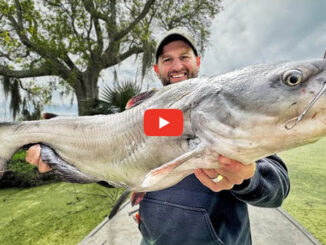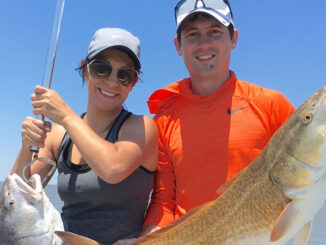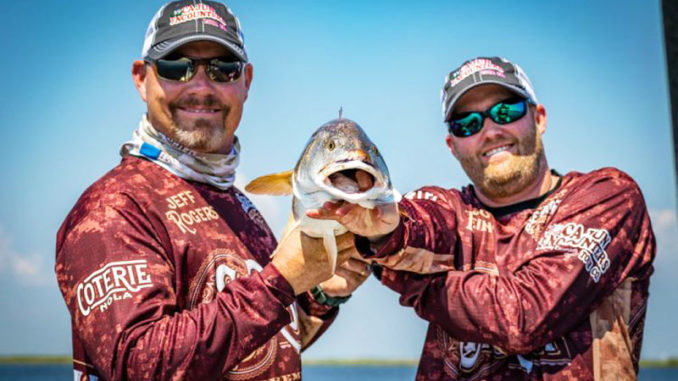
Even if you’re just competing for weekend bragging rights, these insights from a couple of successful tournament anglers will help you put more reds in the boat.
For even the most casual inshore angler, it’s hard to miss the redfish tournament craze that happens every spring and summer.
The popularity of the sport is most certainly due to the quality reds caught along the Louisiana coast. But equally instrumental in the growth of these tournaments is the reality that all anglers — from amateurs to professionals — have an opportunity to battle for a top spot.
“This is a sport that allows us to go out and compete with some of the best guides and anglers in the business, fisherman of all ages and any location,” said Jake Leininger.
He and Jeff Rogers are avid anglers who have been on the redfishing tournament circuit for more than eight years. They teamed up to win the Louisiana IFA Redfish Tour in 2015, and then again in 2017. They’ve also had numerous Top 10 finishes in the Tito’s Vodka Redfish Series (previously the Louisiana Saltwater Series). In a testament to their success, they’ve been rewarded with several sponsorships, including their primary sponsor, St. Roch Vodka.
“The high school glory days have come and gone and the tournament trail has provided us the opportunity to compete and learn a lot about fishing,” Leininger said.
Hooking up a redfish in South Louisiana is about as easy as catching long beads at Mardi Gras, but finding the “right” redfish is truly what separates the winners from the losers on the tournament trail.
‘Goldilocks’ reds
It was the Friday before an upcoming tournament, and I had the opportunity to tag along with the duo while they stalked some of their favorite hunting grounds in the Delacroix area. Patterning a bite wasn’t on the menu; these guys were looking for a specific-sized fish. Within moments of putting the trolling motor down, they spotted a group of reds.
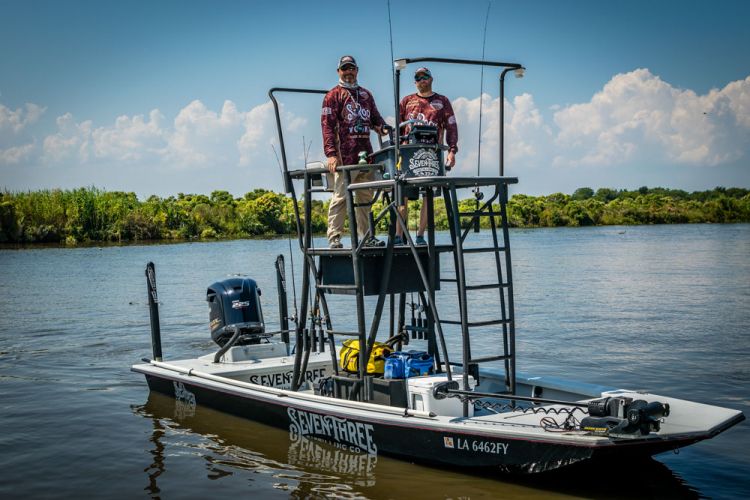
“Right there, right there, right there,” Leininger whispered hurriedly. “No, no. Nevermind,” he said, the excitement leaving his voice. As the boat floated closer, three reds gently headed away in the opposite direction. He could tell the fish didn’t have the “shoulders” they were looking for and wouldn’t make the weight — so there was no point in casting.
There can be a tremendous weight difference between a fish that is 26 inches long and a fish that is 26 7/8 inches long. Three-quarters of an inch doesn’t sound like much, but it can equate to more than a pound at the scales.
But there’s a fine line between an “under” fish and an “over” fish: 1/64-of-an-inch over is still too big.
“We’ve run up on schools of fish. But numbers don’t win tournaments,” Rogers said. “We need to find just the right pedigree of fish; not to big, not too small.”
The air up there
The two men typically work out of a tower boat. Viewing the water from 8 to 10 feet in the air is truly a paradigm shift in fishing. The evolution from traditional blind casting to sight-fishing at that altitude is the equivalent of evolving from black- and-white to HD TV in one jump.
“Any elevation makes a difference. Even if you’re just standing on a Yeti ice chest,” Rogers advised. “And you have to have a good set of polarized sunglasses to go with it, too.”
From that lofty vantage point, blindly casting to the shoreline is a waste; you simply can’t catch fish that aren’t there.
Rogers and Leininger didn’t cast very much, but their eyes remained glued to the water. They didn’t even look up to answer questions. They just kept dissecting the water; and not only the area immediately adjacent to the boat. Surprisingly, they scan the water at the edge of casting range, too.
After almost a decade of time on the water, they only need to capture a glimpse of a red to make a pitch. And sight-fishing gives them the opportunity to truly observe a redfish’s reaction to a particular bait. These guys aren’t shy about employing a myriad of lures and in a variety of colors. They let the conditions and fish’s response dictate the bait du jour.
Dinner is served
But tailing reds on a distant flat may not stick around long enough to make a close pitch.
“A 3/4-ounce gold spoon will allow you to cast a country mile,” Leininger said. “And a flashy spoon can also work in rough or dingy water.”
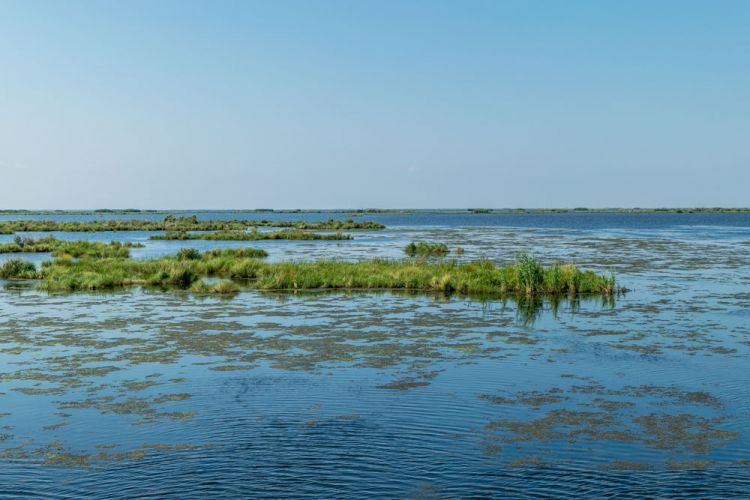
In clear water conditions, the pair typically pitch swimbaits like Berkley Gulp Shrimp on 3/8-ounce jigheads. When fishing thick aquatic vegetation, they’ll use any variation of plastics like grubs, crawfish or even Ribbit frogs, usually with a 1/4-ounce bullet weight Texas-rigged to remain weedless.
Regardless of the conditions, presentation remains key to soliciting a strike.
Consider a wonderful Ruth’s Chris New York Strip, for example. Swimming in sizzling melted butter, it’s a meal fit for a king. But served on a trash can lid —well, not that appetizing, right?
So if a fish bolts on the cast or turns tail when a grub’s dropped on its nose, your lure is probably on that trash can lid.
“Knowing how to use the right bait in the right condition is essential,” Leininger said.
Tournament anglers need to have a stealthy presentation to fish that are right on the boat. Other times, working a swimbait is what’s needed to entice a fish out of a grass mat.
The bottom line is redfish can be finicky, so the trick is presenting your favorite plastic like it’s as tasty as that New York Strip.
Public vs. private waters
The marsh you fish is a big deal, and not just because some spots hold fish and others don’t. Tournament anglers are not allowed to fish private waters that are not openly available to the public at large. Navigating the “private but open” versus “private and closed” water issue has become a tricky obstacle for tournament fisherman.
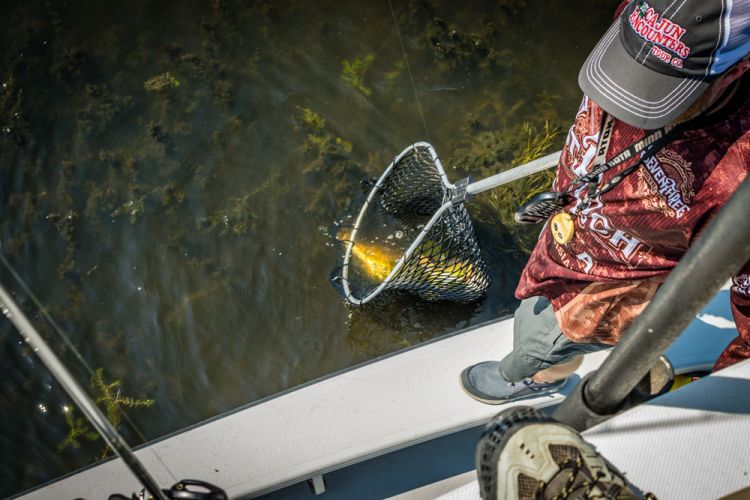
Places like Delacroix are predominantly private, but generally open to public fishing. In contrast, private waters in areas like Lafitte and Cocodrie are more often closed to public access. This is the reason tournament anglers have begun shifting away from these locations.
“I’ve taken several lie detector tests over the years to confirm we are fishing within the tournament rules,” Rogers noted.
It may sound like simple advice: Don’t fish where land owners have posted their property. But there isn’t a single map resource that precisely defines what is “out of bounds.” The continually dissolving Louisiana marsh doesn’t provide clear geographic boundaries, either. So it’s up to the anglers to know where they’re fishing.
And it takes good old-fashioned experience to know where you can — and can’t — fish.
It takes two
“There he is,” Rogers grunted under his breath, as the drag on his reel came tight.
But tying into a red that’s better than 8 pounds, buried in widgeon grass and pulling like a truck is a recipe for a break-off. The objective is to put the fish in the boat as quickly as possible. These guys aren’t at it to enjoy the fight, so heavy drag, a stiff rod spine and braided line are a must. If necessary, they will literally drag a fish into the boat.
“Get the net. Get the net,” Rogers almost pleaded, as Leininger secured the red.
Being 10 feet up in the air on a 3- by 4-foot platform makes it pretty tough to land winning fish solo. That’s where you need to have a partner to boat heavy fish, and it was clear the dance between Rogers and Leininger had obviously been well-rehearsed.
Stopping the trolling motor and putting the Power-Pole down are a must. They didn’t want the boat drifting into other fish and blowing out the entire pond.
Leininger was down the tower and on the deck almost immediately, grabbing the net and scooping the fish in one fluid motion. A mass of redfish and aquatic vegetation hit the floor of the tower boat with a thud. After separating the surf from the turf and a quick measurement, Jake gives a nod confirming the fish was short of the slot.
“Now that’s a tournament fish,” Rogers said, without even weighing it. “It’s a ‘heavy.’ We’ll hit this tomorrow.”
Pros like Leininger and Rogers make it look easy, but being a novice doesn’t disqualify you, either. The redfish tournament circuit is already heating up and carries throughout the summer into early fall. Just remember, it’s all about the right fish. So if you can consistently find a ‘heavy,’ you can compete on the redfish circuit.
Play the ‘slots’ during redfish tournament

For the uninitiated, redfish tournaments might seem the same as any other rodeo, where the heaviest fish wins. The difference is the introduction of the slot-sized fish; meaning only a certain length fish will do.
Most redfish tournaments weigh-in the two heaviest live redfish under 27 inches. Tito’s Vodka Redfish Series anglers weigh-in three live fish; two under 28 inches and one under 27 inches.
Livewell tips
Weight deductions of half, to as much as a full pound, are assessed if tournament anglers bring in a dead fish. But it’s a delicate process to keep redfish alive in 90-plus degree temperatures in the blistering heat of Louisiana summers.
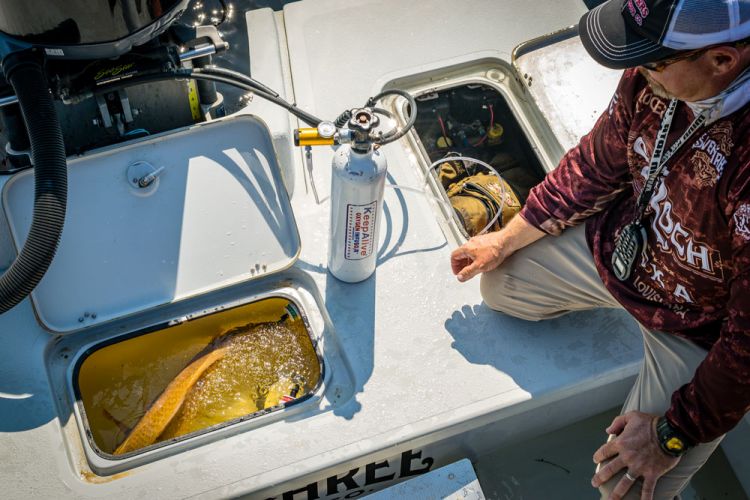
Best practices for keeping them swimming include:
- Using additives – Rejuvenade is a product added to the water in your livewell. Use it when initially filling the livewell, and then again halfway through the day.
- Clean water – Don’t fill the livewell with water from the pond you’re fishing. Larger water bodies adjacent to the interior marsh tend to be cooler and better oxygenated.
- Oxygen – Use a supplemental supply of oxygen in lieu of a standard aerator. More oxygen in the water makes it easier for the fish to breathe; which puts less stress on them so they’ll be in good shape at the weigh-in.
- Keep the temperature down – Use frozen water bottles as opposed to dumping raw ice into the livewell, which can ultimately affect the salinity.

